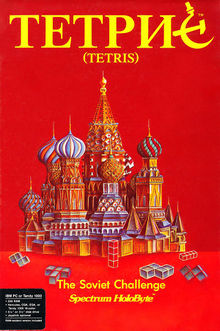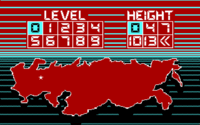Tetris (Spectrum HoloByte): Difference between revisions
No edit summary |
|||
| (23 intermediate revisions by 6 users not shown) | |||
| Line 1: | Line 1: | ||
{{Infobox |title = Tetris | {{Infobox |title = Tetris | ||
|developer = Spectrum HoloByte | |developer = [[Spectrum HoloByte]] | ||
|publisher = Spectrum HoloByte | |publisher = [[Spectrum HoloByte]] | ||
|released = | |released = {{unbulleted list| | ||
|platform = | *{{release|January 1988}} (DOS)<!-- https://www.nytimes.com/1988/01/29/business/new-software-game-it-comes-from-soviet.html?pagewanted=all New Software Game: It Comes From Soviet] (1988-01-29) --> | ||
|preview = | *{{release|July 1988}} (Apple II, IIGS, Mac) | ||
|playfield = | *{{release|December 1988}} (Amiga) | ||
*{{release|March 1989}} (Atari ST) | |||
}} | |||
|platform = {{Unbulleted list| | |||
*DOS | |||
*Amiga | |||
*Apple II | |||
*Apple IIGS | |||
*Apple Macintosh | |||
*Atari ST | |||
}} | |||
|preview = 1 | |||
|playfield = 10 × 20 | |||
|hold = No | |hold = No | ||
|hard = | |hard = Hard only | ||
|system = | |system = Identical to [[Sega Rotation]], except the vertical state of the S tetromino is shifted 1 space right | ||
|boxart = Spectrum | |boxart = Tetris_(Spectrum HoloByte) boxart.jpeg | ||
|title-scrn = Spectrum Holobyte Tetris | |sub-game = '''DOS version''' | ||
|ingame-scrn = Spectrum Holobyte Tetris Level 0.png | {{Infobox | child=yes | decat=yes | ||
|title-scrn = Spectrum Holobyte Tetris Title Screen.png | |||
|ingame-scrn = Spectrum Holobyte Tetris Level 0.png | |||
}} | |||
|sub-game2 = '''Amiga version''' | |||
{{Infobox | child=yes | decat=yes | |||
|title-scrn = 209846-tetris-amiga-screenshot-title-screen-spectrum-holobyte.png | |||
|ingame-scrn = 209856-tetris-amiga-screenshot-level-9-spectrum-holobyte.png | |||
}} | |||
|sub-game3 = '''Apple II version''' | |||
{{Infobox | child=yes | decat=yes | |||
|title-scrn = 958942-tetris-apple-ii-screenshot-title-screen.png | |||
|ingame-scrn = 958951-tetris-apple-ii-screenshot-soviet-olympic-stadium.png | |||
}} | |||
|sub-game4 = '''Apple IIGS version''' | |||
{{Infobox | child=yes | decat=yes | |||
|title-scrn = 257818-tetris-apple-iigs-screenshot-loading-screen.png | |||
|ingame-scrn = 257824-tetris-apple-iigs-screenshot-morning-ride-near-yakutsk.png | |||
}} | |||
|sub-game5 = '''Atari ST version''' | |||
{{Infobox | child=yes | decat=yes | |||
|title-scrn = 210138-tetris-atari-st-screenshot-title-screen-spectrum-holobyte.png | |||
|ingame-scrn = 210143-tetris-atari-st-screenshot-soyuz-liftoff-spectrum-holobyte.png | |||
}} | |||
|sub-game6 = '''Mac version''' | |||
{{Infobox | child=yes | decat=yes | |||
|title-scrn = 203099-tetris-macintosh-screenshot-title-screen-mac-ii-version.png | |||
|ingame-scrn = 203104-tetris-macintosh-screenshot-level-8-mac-ii-version.png | |||
}} | |||
}} | }} | ||
'''''Tetris''''' is the first Tetris game developed and released by [[Spectrum HoloByte]], and the first version to be released commercially. | |||
There are two versions of the DOS release; the revised version has the plane on the title screen removed (at the request of Elorg) and the military-themed backgrounds replaced (at the request of Pajitnov). The other Spectrum Holobyte versions were based on the revised version. | |||
==Timing== | |||
{{expand section|levels}} | |||
Timing is based on video frames, which are approximately 1/70 of a second. | |||
* [[Gravity]] makes a piece fall by one row every 20 - (level * 2) frames. | |||
* [[Lock delay]] is 16 frames. | |||
* [[Line clear]] delay is 20 frames. | |||
* [[ARE]] is 2 frames. | |||
==Scoring== | |||
[[Image:Spectrum Holobyte Tetris Main Menu.png|thumb|left|200px|Level Select screen]] | |||
Placing a piece awards score according to the following formula: | |||
* points = 4 + (2 * level) + row number of top of piece | |||
The bottom row is number 1. If the piece was dropped manually, the position before dropping is used, so for a high score the player should drop as soon as possible. | |||
If piece preview is enabled at the time a piece is placed, a 25% penalty is assessed: (both divisions are rounded down) | |||
* points with preview on = floor(points / 2) + floor(points / 4) | |||
No additional points are awarded for line clears. | |||
==Development== | |||
Under the presumption that a proper license to Tetris had been secured, Robert Stein began shopping the title around to various publishers. One notable publisher to pass on this option was Broderbund.<ref>https://spillhistorie.no/a-chat-with-gary-carlston-of-broderbund/</ref><ref>https://twitter.com/jmechner/status/1803144901409820835</ref> Ultimately, the rights to produce Tetris for home computers were licensed to Mirrorsoft in Europe and its sister company Spectrum HoloByte in America. As Spectrum HoloByte had also merged with Gilman Louie's development company Nexa Corporation (under a holding company Sphere Inc.), development was carried out by staff and contractors of all three related companies. | |||
The DOS version was developed in 8086 assembly at the Nexa office in San Francisco, CA. The Amiga and Atari ST versions was initially assigned to John Jones-Steele, who programmed the conversions of [[Tetris_(Mirrorsoft)|Mirrorsoft's Tetris]] for the same platforms previously. However, the initial approach of auto-converting the original 8086 code to 68000 code had issues with poor performance and other bugs. As such, Nexa programmers Kevin Seghetti and Gary Poon took over the Amiga and Atari ST projects to clean them up for release.<ref>https://gdri.smspower.org/wiki/index.php/Interview:Kevin_Seghetti</ref><ref>https://asianamericanbooks.com/newsletter/2023aug-article2.html</ref> | |||
The Apple II and Macintosh versions were handled by Spectrum HoloByte, and were written from scratch. The Macintosh version was contracted to Roland Gustafsson, who had previous experience programming his own fan game "Quadris" after playing a copy of [[Tetris_(IBM_PC)|Vadim Gerasimov's port of Tetris]] that was sent to Broderbund for consideration for licensing.<ref>https://www.wired.com/2012/04/prince-of-persia-source-code/</ref><ref>https://www.patreon.com/posts/interview-with-106706105</ref> | |||
As a result of the contract disputes over the rights to Tetris, Robert Stein ultimately lost any rights to produce home computer versions of Tetris. As a result, Spectrum HoloByte entered into a contract directly with Elorg in order to legitimize their license to produce their version of the game, as well as future sequels such as [[Super Tetris]] and [[Tetris Classic]].<ref>https://archive.org/details/0966961706/page/340/mode/2up</ref> | |||
<!-- | |||
==External Links== | ==External Links== | ||
The TSR utility [https://archive.org/details/DIVEFIX2_ZIP DivEFix v2.0] may be needed to fix divide overflow errors when running the game on a modern PC. <!-- A really modern PC, of course, won't run the game at all --> | |||
==See also== | ==See also== | ||
*[[ | *[[Tetris Gold]] - A compilation release which included the DOS version. | ||
== References == | |||
<references /> | |||
== External links == | |||
[https://strategywiki.org/wiki/Tetris_(Spectrum_Holobyte) Tetris (Spectrum HoloByte) on StrategyWiki] | |||
[[Category:Official Tetris games]] | |||
[[Category:Classic computer games]] | |||
{{Spectrum HoloByte games}} | |||
Latest revision as of 01:37, 18 November 2024
| Tetris | |
|---|---|
 | |
| Developer(s) | Spectrum HoloByte |
| Publisher(s) | Spectrum HoloByte |
| Platform(s) |
|
| Release |
|
| Gameplay info | |
| Next pieces | 1 |
| Playfield size | 10 × 20 |
| Hold piece | No |
| Hard drop | Hard only |
| Rotation system | Identical to Sega Rotation, except the vertical state of the S tetromino is shifted 1 space right |
| DOS version | |
| Amiga version | |
| Apple II version | |
| Apple IIGS version | |
| Atari ST version | |
| Mac version | |
Tetris is the first Tetris game developed and released by Spectrum HoloByte, and the first version to be released commercially.
There are two versions of the DOS release; the revised version has the plane on the title screen removed (at the request of Elorg) and the military-themed backgrounds replaced (at the request of Pajitnov). The other Spectrum Holobyte versions were based on the revised version.
Timing
Timing is based on video frames, which are approximately 1/70 of a second.
- Gravity makes a piece fall by one row every 20 - (level * 2) frames.
- Lock delay is 16 frames.
- Line clear delay is 20 frames.
- ARE is 2 frames.
Scoring

Placing a piece awards score according to the following formula:
- points = 4 + (2 * level) + row number of top of piece
The bottom row is number 1. If the piece was dropped manually, the position before dropping is used, so for a high score the player should drop as soon as possible.
If piece preview is enabled at the time a piece is placed, a 25% penalty is assessed: (both divisions are rounded down)
- points with preview on = floor(points / 2) + floor(points / 4)
No additional points are awarded for line clears.
Development
Under the presumption that a proper license to Tetris had been secured, Robert Stein began shopping the title around to various publishers. One notable publisher to pass on this option was Broderbund.[1][2] Ultimately, the rights to produce Tetris for home computers were licensed to Mirrorsoft in Europe and its sister company Spectrum HoloByte in America. As Spectrum HoloByte had also merged with Gilman Louie's development company Nexa Corporation (under a holding company Sphere Inc.), development was carried out by staff and contractors of all three related companies.
The DOS version was developed in 8086 assembly at the Nexa office in San Francisco, CA. The Amiga and Atari ST versions was initially assigned to John Jones-Steele, who programmed the conversions of Mirrorsoft's Tetris for the same platforms previously. However, the initial approach of auto-converting the original 8086 code to 68000 code had issues with poor performance and other bugs. As such, Nexa programmers Kevin Seghetti and Gary Poon took over the Amiga and Atari ST projects to clean them up for release.[3][4]
The Apple II and Macintosh versions were handled by Spectrum HoloByte, and were written from scratch. The Macintosh version was contracted to Roland Gustafsson, who had previous experience programming his own fan game "Quadris" after playing a copy of Vadim Gerasimov's port of Tetris that was sent to Broderbund for consideration for licensing.[5][6]
As a result of the contract disputes over the rights to Tetris, Robert Stein ultimately lost any rights to produce home computer versions of Tetris. As a result, Spectrum HoloByte entered into a contract directly with Elorg in order to legitimize their license to produce their version of the game, as well as future sequels such as Super Tetris and Tetris Classic.[7]
See also
- Tetris Gold - A compilation release which included the DOS version.
References
- ↑ https://spillhistorie.no/a-chat-with-gary-carlston-of-broderbund/
- ↑ https://twitter.com/jmechner/status/1803144901409820835
- ↑ https://gdri.smspower.org/wiki/index.php/Interview:Kevin_Seghetti
- ↑ https://asianamericanbooks.com/newsletter/2023aug-article2.html
- ↑ https://www.wired.com/2012/04/prince-of-persia-source-code/
- ↑ https://www.patreon.com/posts/interview-with-106706105
- ↑ https://archive.org/details/0966961706/page/340/mode/2up
External links
Tetris (Spectrum HoloByte) on StrategyWiki
| |||||











